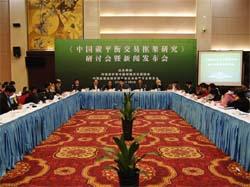

To give different provincial economic entities incentives to reduce their carbon emissions, a report released on 5 Nov. suggests building a carbon trading system based on the carbon balance between the domestic provinces, municipalities, and autonomous regions.
This report, titled Framework Report on Carbon Balance & Carbon Trading of China (later referred to as "the Report"), gives a ranking list of the provincial entities in terms of their total carbon emissions (source) and carbon absorption (sink) and meanwhile proposes a carbon trading mechanism based on the carbon balance between the entities. The expert panel led by the chief-scientist Prof. NIU Wenyuan, a Fellow of the Academy of Sciences for the Developing World (TWAS) and a researcher at the CAS Institute of Policy and Management (IPM), made a survey on the status quo of the carbon balance over the country and reported the statistics based on a set of calculations independently performed by them.
Based on the statistics, states the expert panel, a Carbon Fund and an Ecological Compensation Fund should be established in China. Essentially, entities whose carbon emissions go beyond their carbon absorption would need to pay to the Carbon Fund for their excessive emissions.
Thus raised, the Carbon Fund would serve for subsidizing the leading net carbon sinks, boosting the National Clean Development Mechanism (CDM), supporting innovations in energy-saving and emission-reducing technologies and so on. Provincial entities that contribute to the environment as net carbon sinks would receive ecological subsidies, so as to encourage efforts to preserve the ecology and increase carbon absorption.
Under the umbrella of this trading system, with the only exceptions of Yunnan, Qinghai provinces and Tibet autonomous region, all the other entities would have to pay for their excessive emissions in proportion to their carbon sinks.
As for the operation of the Ecological Compensation Fund of China, as designed in the Report, would be based on a baseline defined as the national net carbon emission. Starting from this baseline, different provinces, autonomous regions and municipalities each will get a quota of carbon emission credit in proportion to its economic scale. Any provincial entity that goes beyond its credit would have to pay for its extra emission, whereas an entity whose carbon emissions stay within the quota would be warranted to receive a sum of compensation, in proportion to its relative contribution to the overall carbon balance of the nation. The fund would be appropriated for ecological compensation in the same year as it is levied. It is anticipated to foster the ecological construction, modulation of economic structure and transformation of consumption in the entities.
If this designed system is introduced, the top three payers of carbon credit will be Shandong, Shanxi and Hebei provinces, according to the team's calculations. In light with a low-level compensation scheme given in the Report, Shandong will need to pay a sum as much as 0.11% of its GDP for its excessive emissions. If another scheme, which suggests a higher level of compensation is adopted and come into effect, this province will have to pay as much as 0.32% of its GDP to greener provinces.
The biggest beneficiaries of this suggested ecological compensation fund would be Tibet autonomous region, Qinghai and Yunnan provinces. Calculations show that mostly the credit buyers will come from eastern and middle part of this country, and sellers mostly from the west.
By this way, according to the panel, carbon emission quota will be turned into a scarce resource, and carbon sink capacity into a profitable treasure.
Also suggested in the report is a leadership group in charge of carbon trading over the country. This group would map out the strategies and layout for future carbon emission trading, deal with applications for low-carbon economic programs and manage their operation. It will also coordinate the organization, management, arbitration and supervision affairs of different entities relating to the carbon emission trading, so as to make sure the trading operates in order.
According to Mr. PAN Yue, vice Chinese Minister of Environmental Protection and president of the Association for Environment Culture Advancement of China, this suggested trading scheme is an important part of the environment-economy policies being studied by the government. He stresses that policy innovation is a guarantee for low-carbon development, and this framework would therefore play a great role. He addresses a symposium on the trading scheme: "The framework for carbon trading in China has positive implications to harmonizing the relationship between the economic development and energy/environment preservation of this country. It will play a great role in speeding up the development of low-carbon energy technologies, the transformation of the mode of economic development and the construction of resource-saving society in this country."
Over the past few years, Chinese government has sought to switch its economic locomotive onto a low-carbon track, seeing this as an important turning point on the path to ecological civilization. "High-carbon mode of economic development would badly restrict the future development of China." Remarks Pan.
Related News
Photos
More>>trade
- Scientists call for enhancing studies on chromosome engineering in plants
- Center for human brain recording opens at the Institute of Biophysics
- Science academy leaders meet to discuss innovation systems in Beijing
- China unveils its first full image of the Moon
- Geographer CHEN Shupeng, 88, passes away





